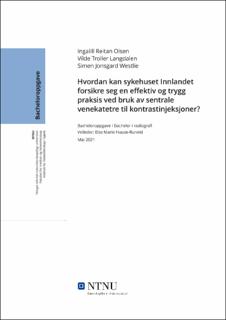| dc.contributor.advisor | Else Marie Huuse- Runeid | |
| dc.contributor.author | Olsen, Ingalill Reitan | |
| dc.contributor.author | Langdalen, Vilde Troller | |
| dc.contributor.author | Jonsgard, Simen Westlie | |
| dc.date.accessioned | 2021-09-24T19:51:17Z | |
| dc.date.available | 2021-09-24T19:51:17Z | |
| dc.date.issued | 2021 | |
| dc.identifier | no.ntnu:inspera:77254816:81631255 | |
| dc.identifier.uri | https://hdl.handle.net/11250/2782352 | |
| dc.description.abstract | Hensikt: Å kartlegge behov for prosedyrer og opplæring i sykehusene i SI, og få oversikt over
hvilke katetre som kan brukes til kontrast og deres spesifikasjoner.
Metode: Det ble brukt kvantitativ metode i form av en spørreundersøkelse for å kartlegge
rutiner på sykehusene i dag og behov for prosedyrer. Utvalget bestod av radiografer som
jobber på CT i SI. Det ble innhentet spesifikasjoner om katetre SI hadde oppgitt at brukes som
ble organisert i tabeller. Det er fem typer sentrale venekateter inkludert i denne oppgaven:
VAP, PICCline, midline, CVK tunnelert og CVK ikke-tunnelert.
Resultater: Spørreundersøkelsen fikk en svarprosent på 23,6%. Nesten alle respondentene
følte behov for prosedyrer og opplæring. VAP var kateteret det var minst usikkerhet rundt,
etterfulgt av PICCline. Behovet var størst for CVK typene.
Konklusjon: Det ses et behov for prosedyrer og opplæring. CVK katetrene er det flest er
usikre på, noe som kan være fordi det bare er én CVK som brukes i SI som er
kontrastkompatibel. Derimot var alle PICCline kontrastkompatible og markert med flow og
psi, noe som kan være årsaken til at det er mindre usikkerhet rundt disse | |
| dc.description.abstract | REVIEW
Research question: How can Sykehuset Innlandet ensure an efficient and safe practice when
using central venous catheters?
Purpose: To map the need for procedures and practice at the hospitals in Sykehuset Innlandet,
and get an overview of which catheters that are contrast compatible and their specifications.
Method: A quantitative method was used in the form of a survey, to map routines in the
hospitals and the need for procedures. The selection consisted of radiographers that work in
CT in SI. Specifications about the catheters that SI use was organised into tables. Five types
of central venous catheters were included in this bachelor: VAP, PICCline, midline, tunneledand non-tunneled CVC.
Results: The survey hade a response rate of 23,6%. Almost all participants felt a need for
procedures and training. VAP was the catheter with the least uncertainty around it, followed
by PICCline. The need was biggest for both CVC types.
Conclusion: A need for procedures and training can be seen. The CVC catheters are what
people are most uncertain about, which could be because only one CVC that SI uses is
contrast compatible. On the other hand, all PICClines were contrast compatible and marked
with flow and psi, which could be the reason there are less uncertainty with these | |
| dc.language | nob | |
| dc.publisher | NTNU | |
| dc.title | Hvordan kan sykehuset Innlandet sikre seg en effektiv og trygg praksis ved bruk av sentrale venekatetre til kontrastinjeksjoner? | |
| dc.type | Bachelor thesis | |
